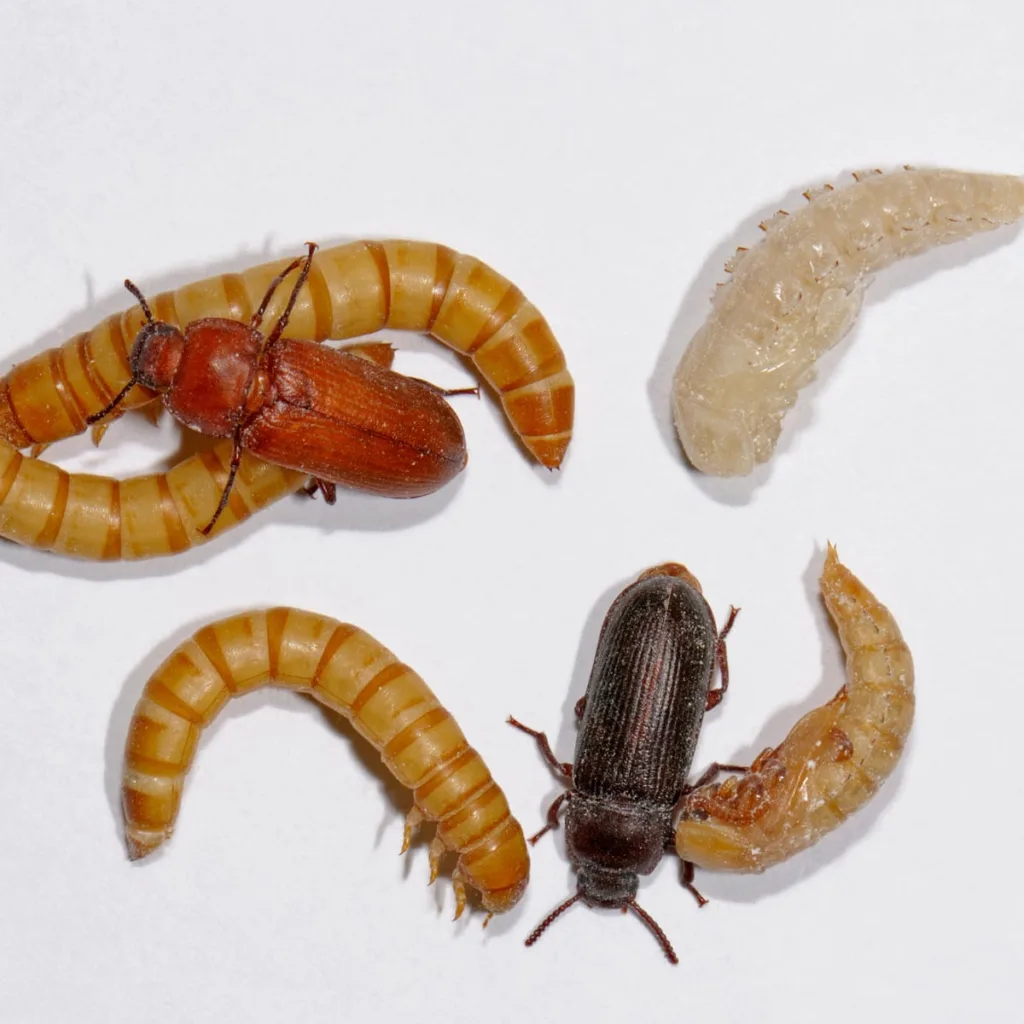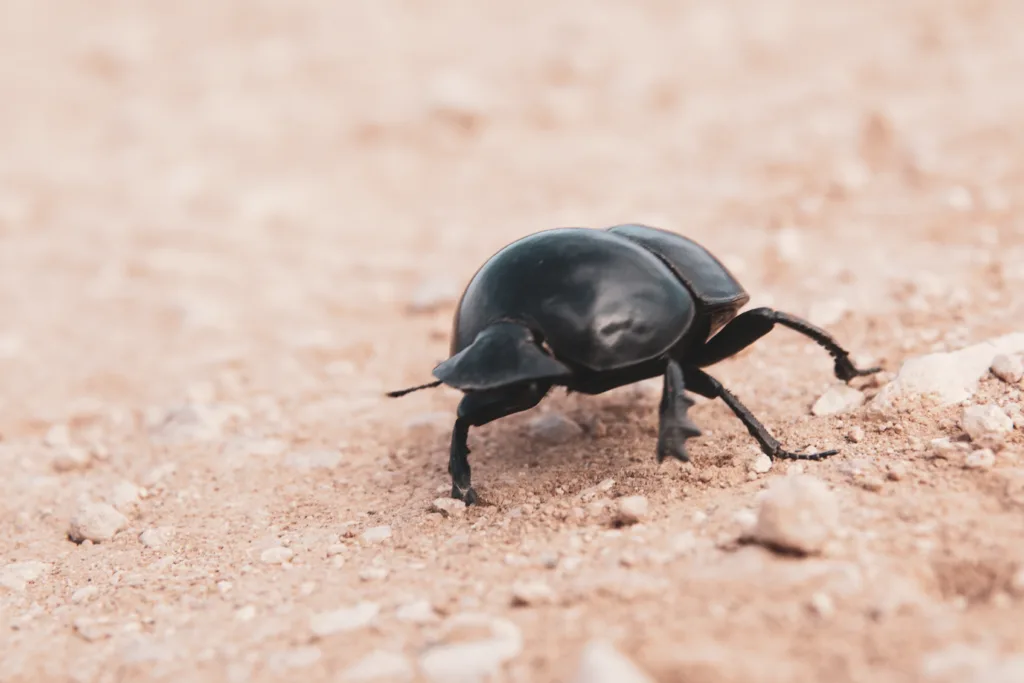Mealworms are a fascinating and commonly found insect that are often used as a food source for pets such as reptiles and birds. But did you know that mealworms actually turn into beetles? In this blog post, we’ll explore the life cycle of mealworms and the transformation they undergo to become beetles.
Mealworms are the larvae of darkling beetles and are commonly found in stored grain products, such as flour and cereal. They have a distinct appearance, with a long, cylindrical body and six small legs. Mealworms are scavengers and omnivores, feeding on decomposing plant material, dead insects, fungi, and stored products.
After about three weeks of feeding, mealworms will enter the pupal stage. During this time, they will form a cocoon around themselves and undergo metamorphosis. After about one to three weeks, the pupae will emerge as beetles.
At first, the beetle is white or light beige with a soft shell. As it matures, the shell darkens and hardens, turning red, brown, and finally dark brown or black after about two to seven days. The beetle has a distinct appearance, with a hard, shell-like body and two large antennae.
While mealworms are not considered dangerous, they can infest and contaminate food products. It’s important to store grain products in airtight containers to prevent mealworm infestations. In many cases, however, mealworms are intentionally bred and used as a food source for pets.
Mealworms are a fascinating insect that undergo a remarkable transformation to become beetles. While they are considered a pest in certain situations, they are also a valuable food source for pets. Understanding the life cycle of mealworms can help us appreciate the complexity of the natural world around us.
Time Required for Mealworms to Transform into Beetles
Mealworms take about 1-3 weeks to turn into beetles. During this time, the mealworm goes through the pupal stage of development, where it metamorphoses into a beetle. Initially, the beetle is white or light beige, with a soft shell. Over the course of 2-7 days, the beetle darkens and hardens, eventually turning red, brown, and finally dark brown or black. This process of transformation is a natural part of the mealworm life cycle and is essential for the reproduction of the species.

Are Mealworm Beetles a Threat?
Mealworm beetles are not typically considered harmful to humans. They are not known to carry any diseases or pose any significant health risks. However, they can infest and contaminate stored food products, which can lead to spoilage and waste. Additionally, mealworms and teir larvae are often used as a food source for pets such as reptiles and birds. In these cases, it is important to ensure that the mealworms are properly sourced and prepared in order to avoid any potential health issues for the pets. Overall, while mealworm beetles may be considered a nuisance due to their propensity to infest stored food, they do not pose a significant danger to humans or animals when handled and prepared appropriately.
Are Darkling Beetles a Threat?
Darkling beetles are generally not considered harmful to humans or the environment. In fact, the vast majority of darkling beetles live in the wild and play an important role in the ecosystem as scavengers and decomposers. They feed on decomposing plant material, dead insects, fungi, and stored products. While there are a few species of darkling beetles that are considered pests, the damage they cause is typically limited to stored crops and products. Overall, darkling beetles are not a significant threat to human health or the environment.
Can Mealworm Beetles Invade Your Home?
Mealworm beetles, also known as Tenebrio molitor, are not commonly found infesting homes. These beetles are typically kept as pets, used for scientific research, or used as a food source for reptiles and other animals. While mealworm beetles do have the potential to infest stored grains and cereals, they are not known to infest homes. Mealworm larvae have short legs and both adults and larvae tend to wander away from their food sources, making it unlikey that they will establish a home in your living space. However, it is still important to properly store and dispose of any food sources to prevent attracting any unwanted pests. Overall, the chances of mealworm beetles infesting anything in your home are slim.
Feeding Mealworms to Keep Them Alive
Yes, mealworms need to be fed in order to stay alive. Mealworms require a regular intake of nutrients such as carbohydrates, proteins, and fats to sustain their bodies and maintain their growth. In the absence of food, mealworms can become weak, malnourished, and eventually die. Hence, it is essential to provide them with a balanced diet consisting of fruits, vegetables, grains, and other nutritious food sources. Additionally, mealworms also require access to clean water to prevent dehydration and maintain their health. Overall, proper feeding and hydration are crucial for the survival and well-being of mealworms.

Source: homesciencetools.com
Do Mealworms Pose a Risk of Disease Transmission?
Yes, mealworms can carry disease. They are known to feed on dead and dying birds, which can expose them to various pathogens such as Salmonella, Escherichia coli, or infectious bursal disease virus. These pathogens can then be transmitted to other animals or humans who come into contact with the mealworms. To reduce the risk of disease transmission, it is important to handle mealworms properly, including washing hands thoroughly after handling them and ensuring they are stored in a clean and hygienic environment. Additionally, it is recommended to purchase mealworms from reputable sources that follow proper hygiene and safety protocols.
Lifespan of a Mealworm
The lifespan of a mealworm varies depending on their life stage. As larvae, they can live for several months, typically between 2 to 4 months. During this time, they will molt several times before pupating. The pupal stage lasts around 7 to 10 days before the adult beetle emerges. Once an adult, the mealworm beetle can live for an additional 3 to 12 months. It’s important to note that their ability to fly allows them to easily travel and infest new areas, so proper pest control measures should be taken to prevent infestations.
Can Mealworms Pose a Health Risk to Humans?
There is no evidence to suggest that mealworms can infect humans. In fact, mealworms have been consumed as a food source in many cultures for centuries and are considered safe for human consumption. The European Food Safety Authority (EFSA) has conducted a safety assessment of dried yellow mealworms and concluded that they are safe for human consumption. Mealworms are also used in the production of animal feed and pet food and are considered to be a sustainable and nutritious protein source. However, it is important to ensure that mealworms are properly prepared and cooked befre consumption to reduce the risk of any potential bacterial contamination.
The Effects of Different Factors on Mealworms
There are several methods to kill mealworms, including heat treatment, freezing, drowning, and uing insecticides. However, the most effective and convenient way to kill mealworms is by heating them. This can be done by placing the infested food in a container and heating it in an oven at 130° F to 150 °F for 30 minutes. This temperature range is lethal to mealworms, but it won’t damage most food items. Freezing is also an option, but it may take longer to kill the insects and requires a temperature of -4°F or lower. Drowning the mealworms in soapy water is another option, but it’s not as effective as heat treatment or freezing. Using insecticides is not recommended for killing mealworms in food, as it may leave harmful residues on the food and pose a health risk to humans and animals. Therefore, if you want to get rid of mealworms, it’s best to use heat treatment or freezing.
Do Mealworms Transform Into Other Organisms?
Yes, mealworms undergo a metamorphosis process and transform into a different form. The mealworms go through several stages of development before they turn into pupae. After a few weeks of being in the pupal stage, the pupae transform into adult mealworm beetles, also known as darkling beetles. These beetles look vastly different from the mealworms and have wings, unlike the larvae. Therefore, mealworms do not stay the same and turn into something entirely different during their life cycle.
What Attracts Darkling Beetles?
Darkling beetles are attracted to organic matter, specifically manure or litter. This is because they feed on the decaying organic material, which provides both nourishment and a habitat for them. The beetles are also attracted to warm and humid environments, which are commonly found in poultry farms. Additionally, darkling beetles are able to detect odors from their potential food sources, and will seek out areas where these odors are present. This is why it is important for poultry farmers to regularly clean and remove manure and litter, to prevent the buildup of organic matter which can attract these pests.

Conclusion
In conclusion, mealworms are a common insect that undergoes a complete metamorphosis, starting as an egg, hatching into a larva, and eventually transforming into a pupa and then a darkling beetle. They are often used as a source of protein for pets like reptiles and birds, but can also be found infesting and contaminating stored food products. However, they themselves are not considered a danger to humans and do not pose any harm to the environment. Overall, mealworms are fascinating creatures that play an important role in the ecosystem as scavengers and decomposers.
